Introduction: Gena Philibert-Ortega is a genealogist and author of the book “From the Family Kitchen.” In this blog article, Gena searches old newspapers to find articles and advertisements that show what our ancestors wore during the hot summer months.
I don’t know about where you live, but here in California it is HOT. This week has been hot and humid, something we are not as used to since we normally live with a “dry heat.” So as the temperature goes up people try all sorts of ways to keep cool, including altering the way they normally dress. A few days ago I was standing in line at the bank and a woman in her bathing suit was in front of me! Because it is warm all year long here, I would say the concept of “summer fashion” is lost on most of us Californians.
Typically in most places, however, each season brings with it new fashions. It wasn’t too terribly long ago that our ancestors learned about the newest fashion trends via the newspaper. And while swimsuits are a summer fashion must-have (see Great-Grandmother’s Swimsuit in Vintage Fashion Articles & Photos), other summer fashions are important for outdoor activities, social events, and vacationing.
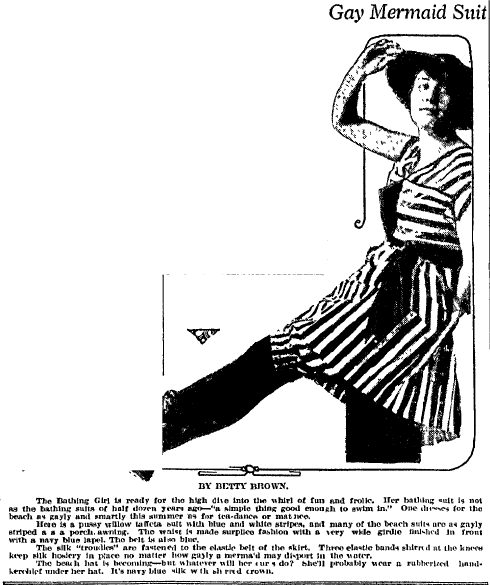
Summer Fashions of Yesteryear
I am grateful fashion trends have changed over the generations because some of the older apparel trends included way too much fabric to wear during hot summer months. Take this 1906 example from Louisiana. The Gibson girl look is well represented in these summer dresses, which are described as being “light” and made from “filmy fabrics.” And while I have no doubt that these linen dresses were much lighter than women’s standard fare at that time, I am grateful I didn’t have to wear that much fabric in a time when air conditioning wasn’t available.
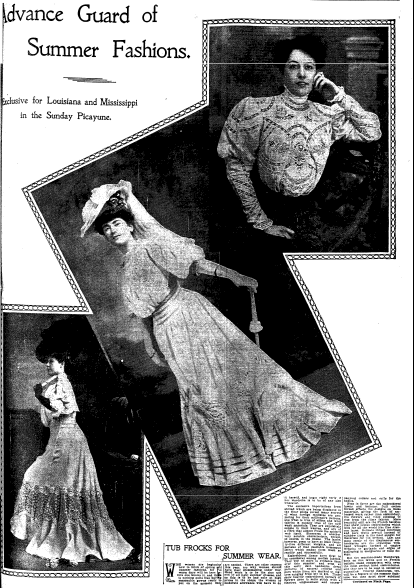
I have to admit I love looking at vintage fashions from the 1920s, and newspaper advertisements provide us with a sense of what clothing was really available to our ancestors for purchase. Sure, it’s interesting to see what models were wearing at fashion shows, but newspaper advertisements verify what styles of apparel were available for the common family.
Take for instance this short-sleeved frock. The reader is informed that “The whole background of summer fashions is white” and the use of “dainty pleatings and exquisite lace trimmings” can be seen in the fashions of 1924.
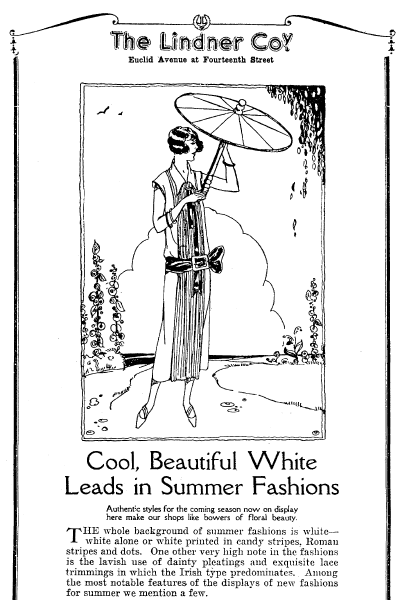
Similarly-styled dresses can be seen in an advertisement on the same page of the Plain Dealer, that proclaims:
When summer comes – it must not find us unprepared. Filmy Frocks of printed or plain georgette, crepe or chiffon, embellished with lace, embroidery or beads, in themselves suggest vine shaded verandas and light laughter, or the joys of the summer evening dance.
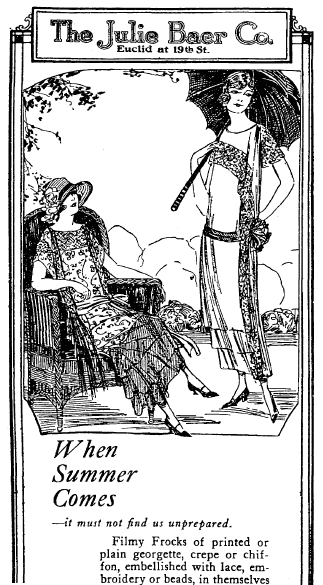
Looking toward Hollywood
Celebrity has always attracted attention – and there is no doubt that, just like today, people have always been interested in what was being worn by the rich and famous. I love the description of the outfits in this 1939 article entitled “Ladies of the Screen Vie with Each Other in Wearing Latest in Summer Fashions.”
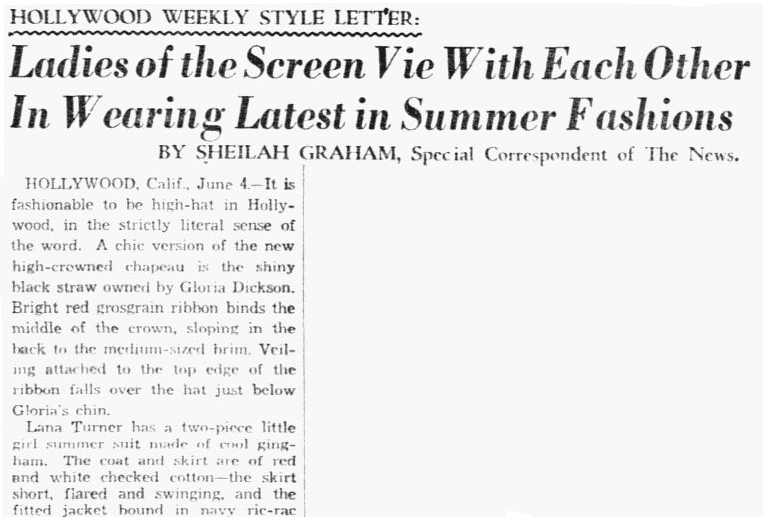
One of the stars mentioned in the piece is Margaret Sullavan who starred opposite Jimmy Stewart in the movie Shop Around the Corner, the inspiration for the Tom Hanks and Meg Ryan film You’ve Got Mail. Sullavan’s outfit is described as:
…new hostess pajamas, the latest in lounging comfort, combine pigskin with a heavy roma crepe. The blond star chooses a watermelon pink shade for the very full trousers, with shirred bodice draped from the plain round neckline. A wide, natural-colored pigskin girdle, studded in silver nailheads, individualizes the suit, and, with it, Miss Sullavan wears a heavy cord snood to keep her curls in line.
Most likely the use of the word pigskin here indicates a type of leather.
A more summer-sounding outfit in the article is described as worn by Lupe Velez who:
…relaxing recently at Palm Springs, wore transparent oilskin fuchsia-colored slacks and bolero over a fuchsia and white striped oil-silk puckerette bathing suit.
(Oil-silk, incidentally, is a material much like that used for men’s tobacco pouches.)
[search_box]
$$$
What did those summer fashions cost our ancestors? I mentioned above how advertisements can provide us images of fashions that were available to our families, but they can also answer questions about the price of the apparel. This large 1933 newspaper advertisement includes sale prices for everything from wool bathing suits to summer coats and dresses.

What shoes would they have worn with that summer wardrobe? Today we mostly think of sandals and flip-flops as summer ware, but fashionistas know you need much more. This ad offers shoes for $1.95 a pair:
Every style in this sale was selected for fashion-rightness. Shoes for all summer occasions – in models for street, sports, daytime and summer resort wear.
Notice that they proclaim to have plenty of white shoes in stock, since white was traditionally worn during the summer months or specifically after Memorial Day and before Labor Day; a fashion “rule” most likely established by high society women to distinguish themselves from everyone else.
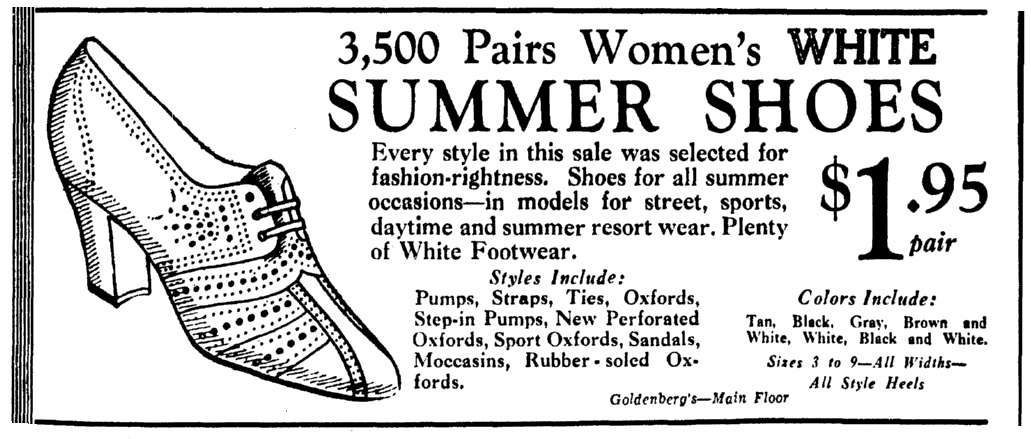
When you find an old newspaper fashion advertisement, take the time to research what the price would translate to in today’s world. Various websites including Measuring Worth can assist you in converting those prices into modern-day sums.
What did your ancestors wear during the summer? While our ideas about what constitutes summer wear have changed over the generations, it’s a good bet that your ancestors chose outfits that would have helped them beat the heat. What did your ancestors wear? Their hometown newspapers provide clues.
Related Fashion Articles:
- Great-Grandmother’s Swimsuit in Vintage Fashion Articles & Photos
- How to Date Family Photos with Vintage Fashion Ads in Newspapers
- How to Date Old Photos of Our Ancestors with Early Fashion Trends
[bottom_post_ad]
